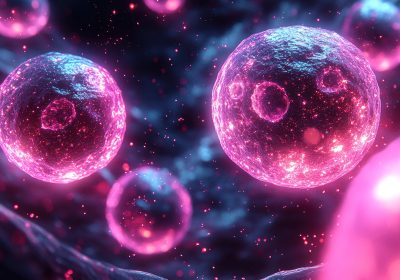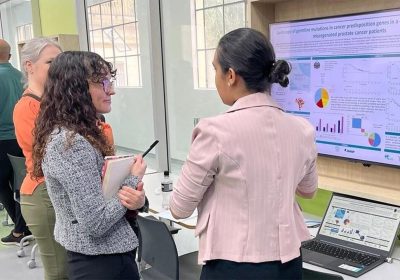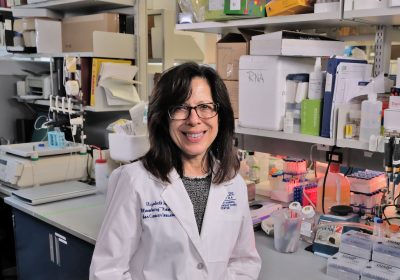
Dr. Elaine R. Mardis Aims for Equal Access to Precision Cancer Genomics
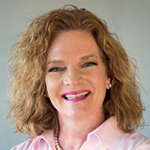
Elaine R. Mardis, PhD, spends a lot of her time studying molecules at the Institute for Genomic Medicine at Nationwide Children’s Hospital in Columbus, Ohio. What she sees is invisible to the naked eye, but her vision for what clinicians can do with the information they find in the genes of a cancer cell is clear.
As the president of the American Association for Cancer Research (AACR), one of
Dr. Mardis’ goals is to help oncologists understand how what she and others see inside a cancer genome—the complete sequence of DNA inside a cancer cell—can inform the treatments they select for their patients.
It was the genome that brought Dr. Mardis into cancer research. After earning her doctorate in chemistry and biochemistry at the University of Oklahoma in Norman, she served as a senior staff scientist at Bio-Rad Laboratories in Hercules, California. In 1993, Dr. Mardis joined the McDonnell Genome Institute at Washington University in St. Louis (formerly known as the Genome Sequencing Center and Genome Institute). The Institute became an important contributor to the Human Genome Project, an international research effort to determine the order, or sequence, of the four nucleotides—A, C, G, and T—found in human DNA. Dr. Mardis, as director of Technology Development, was an integral part of the research team, and, in 2002, she and her colleague Richard K. Wilson, PhD, were selected to serve as the Institute’s co-directors.
In April 2003, and to much acclaim, Dr. Mardis and her colleagues at Washington University were among the international group of researchers who celebrated the announcement that their monumental effort was complete: The human genome had been successfully sequenced two years ahead of schedule. But as often happens in science, what marked an ending simultaneously denoted a new beginning. “Now that we had this wonderful reference sequence that we spent all our hard work putting together,” said Dr. Mardis, “the question was, how do we use it as a foundational tool for investigating human disease?”
Cancer and the Genome
Cancer was the most obvious place to start. “There was now an ability to compare the genome of the cancer cells from patients with their normal or constitutional genome, the one that they were born with,” Dr. Mardis
explained. And through those comparisons, researchers believed, a new understanding of what drives cancer development and how to treat it would arise.
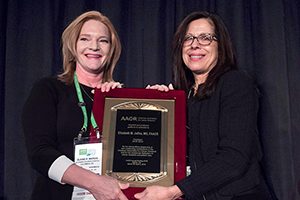
At the time, available technology made genome sequencing slow and expensive. “But then,” said Dr. Mardis, “next-generation sequencing blew everything wide open.” This new technology could sequence an entire human genome—a project that had taken 10 years—in less than a year. With the new technology in hand, Dr. Mardis, Dr. Wilson, and their colleagues started working with Timothy J. Ley, MD, of Washington University to evaluate the genomic changes inside the cells of a patient with acute myeloid leukemia. The results of the team’s research, published in Nature in November 2008, made the front page of the New York Times. The researchers had compared a normal genome of a cancer patient to the patient’s cancer genome using next-generation sequencing and identified the mutations unique to the cancer cells.
“From there,” said Dr. Mardis, “I never looked back in terms of applying next-generation sequencing to important clinical questions that have informed the basic understanding of cancer—of what drives cancer and [how it can be treated] as well.”
Other remarkable papers by Dr. Mardis and her colleagues followed. These included comparisons of primary cancers to their metastases, explorations of human tumors implanted in mouse models (xenografts) compared to the original tumor, and studies using genomics to identify cancer-specific mutations that elicit immune responses and to create personalized vaccines. This research helped pave the way for the field of precision cancer therapy that is flourishing today.
“Elaine Mardis has been an incredibly dynamic leader in the quest to improve our understanding of cancer by analyzing the human genome,” said Margaret Foti, PhD, MD (hc), chief executive officer of the AACR. “Her highly innovative work in DNA sequencing has led to dramatic advances in our knowledge of how genetic mutations can cause cancer to develop and progress. This, in turn, has brought us closer to the goal of personalized medicine, which has helped reduce mortality from the ravages of cancer.”
Matthew Ellis, MD, PhD, the director of the Baylor College of Medicine Breast Center in Houston, who worked closely with Dr. Mardis on two papers published in Nature in 2010 and 2012 while at Washington University, said one of Dr. Mardis’ many assets is her ability to focus on applying research to clinical care. “Her strength is that vision—an understanding of what technology can do and how to apply it in a diagnostic setting, literally up to a decade before anybody made next-generation sequencing a clinical reality. She has a visionary ability in that sense.”
In 2016, after 23 years at Washington University, Dr. Mardis and Dr. Wilson established the Institute for Genomic Medicine at Nationwide Children’s Hospital. There, Dr. Wilson, executive director, and Dr. Mardis, co-executive director, are leading efforts to integrate the genomics of childhood cancers into the diagnosis and clinical care of pediatric patients.
“Kids don’t tend to have many point mutations [mutations that alters only one A, C, G, or T nucleotide] in their genomes,” said Dr. Mardis. “So, it’s a lot harder to identify what’s different about the pediatric cancer genome because many of the changes are what we refer to as epigenetic”—inherited or acquired changes that affect whether cancer genes are turned on or off.
Presidential Goals
During her year as AACR president, which extends to April 2020, Dr. Mardis is spotlighting pediatric, adolescent, and young adult cancers. “I think there is a continuum there that needs to be emphasized,” she explained. These patients are often grouped together, she noted, “but there is a lot to be learned about the differences, as well as the similarities, in their cancer genomes, and I want to emphasize that area of cancer precision medicine.” She would also like to encourage more sharing of genomic and clinical data from these patients in the public domain in order that “all providers can compare their patients to many, many other patients with a similar diagnosis so that we can begin to tease out diagnoses and corresponding treatment paradigms that are effective.”
“The rarity of pediatric and AYA [adolescent and young adult] cancers makes sharing data and providing internet-based tools for data analysis and data comparison imperative to advance the science and clinical care,” she said. “At the end of the day, my ideal is that any cancer patient anywhere with any oncologist should be able to benefit from the wealth of knowledge that is out there.”
This is not the reality now, she acknowledged. “Kids with cancer should not have to be lucky enough to go to one of the best cancer hospitals so that they can survive their disease. These data and tools should be something that oncologists across the world ultimately have access to.”



